Raytheon (Philco/General Electric) AAM-N-7/GAR-8/AIM-9 Sidewinder
The AIM-9 Sidewinder is the world's most successful short-range air-to-air missile, and will remain the U.S. military's main "dogfight" AAM for the foreseeable future.
Development of Sidewinder began in 1950 at the NOTS (Naval Ordnance Test Station) - later renamed as NWC (Naval Weapons Center) - at China Lake. The idea was to create a very simple heat-seeking air-to-air missile by equipping a 12.7 cm (5 in) air-to-air rocket with a lead sulphide (PbS) photo cell in a hemispherical glass nose to detect IR radiation. Another simple, yet effective, idea was the use of "Rollerons" (sliptream-driven wheels at the fin trailing edges acting as stabilizing gyros) as roll-stabilizing devices. The first test missiles were fired in 1951, and on 11 September 1953, the first air-to-air hit on a drone was scored. In the same year, the prototype missile received the offical designation XAAM-N-7.
General Electric began low-rate production in 1955, and in May 1956, the AAM-N-7 Sidewinder I entered U.S. Navy service. Only 240 Sidewinder I missiles were built, and full-rate production missiles (built by Ford Aerospace (Philco) and General Electric) were known as AAM-N-7 Sidewinder IA. I have found no evidence that the AAM-N-7 designations ever used suffix letters (like AAM-N-7a, etc.). For ease of reference, I will use the post-1963 designations of AIM-9A (Sidewinder I) and AIM-9B (Sidewinder IA) throughout this text, even when referring to pre-1963 events.
The AIM-9A/B used a 4.5 kg (10 lb) blast-fragmentation warhead. This was triggered by an IR proximity or contact fuze, and had an effective kill radius of about 9 m (30 ft). The uncooled PbS seeker of these early missiles had a 4° angle of view and a tracking rate of 11°/s, and the missile itself could turn at 12G. Propulsion was provided by a Thiokol MK 17 solid-fuel rocket motor (17.8 kN (4000 lb) thrust for 2.2 s), which could propel the missile to a speed of Mach 1.7 above launch speed. Because of the limitations of the seeker, the AIM-9A/B could only be used for tail-on engagements of non-manoeuvering(!) targets at ranges between 900 m (3000 ft) and 4.8 km (2.6 nm). The missile was also very susceptible to other heat sources (sun, ground reflections).
Because of the usual inter-service rivalry, the USAF did not adopt the Sidewinder, until a "fly-off" against the USAF's GAR-2/AIM-4B Falcon in June 1955 showed the superiority of the Sidewinder. The USAF subsequently procured the AIM-9B under the designation GAR-8. More than 80000 AIM-9B missiles were produced until 1962.
On 24 September 1958, the Sidewinder achieved the world's first successful use of air-to-air guided missiles, when Taiwanese F-86Fs shot down Communist Chinese MiG-15s using AIM-9Bs supplied by the U.S. Navy.
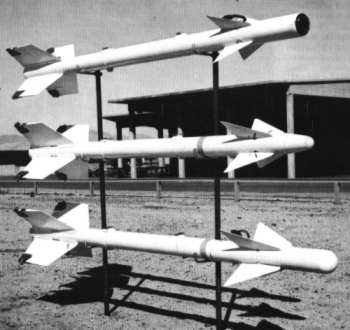 |
| Photo: via Jane's |
| From top: AIM-9B, AIM-9D, AIM-9C |
The limited performance of the AIM-9B prompted the Navy to look for improvements. The AAM-N-7 Sidewinder IC was developed in two version: a semi-active radar homing version (called Sidewinder IB in source [1]), designated AIM-9C in 1963, and an IR guided version, later designated as AIM-9D. Improvements common to both IC versions include a new Hercules MK 36 solid-fuel rocket motor for significantly increased speed and 18 km (9.7 nm) range, a larger MK 48 continuous-rod warhead, and slightly larger fins.
The SARH AIM-9C was only used with the Navy'S F8U Crusader fighters to provide these with an all-weather capability without having to fit a Sparrow-compatible radar. However, the AIM-9C was not very successful, and only 1000 were built by Motorola between 1965 and 1967. Many were later converted into AGM-122A Sidearm anti-radiation missiles.
The IR seeker of the AIM-9D (in a more pointed nose) featured a new nitrogen-cooled PbS seeker, which had field of view of only 2.5° (reduced background noise) and a higher traking rate of 12°/s. However, only about 1000 AIM-9D missiles were built (by Philco-Ford and Raytheon) between 1965 and 1969.
The following table summarizes the redesignations of the Sidewinder variants in June 1963:
| Old Designation | New Designation |
|---|---|
| AAM-N-7 Sidewinder I | AIM-9A |
| AAM-N-7 Sidewinder IA GAR-8 |
AIM-9B |
| AAM-N-7 Sidewinder IC (SARH) | AIM-9C |
| AAM-N-7 Sidewinder IC (IR) | AIM-9D |
A training version of the AIM-9D for captive flight target acquisition, which had the warhead replaced by a WDU-9/B dummy warhead, was later designated as ATM-9D. The WDU-9/B is also used in all subsequent inert ATM/CATM/NATM-9 versions. Early training Sidewinders for firing practice were designated GDU-1/B.
The AIM-9E was the first version specifically developed by the USAF. It was an improved AIM-9B with a new seeker with thermoelectric (Peltier) cooling, and a higher tracking rate of 16.5°/s. The Peltier cooling method allowed unlimited cooling time while the missile was on the launch rail. Externally, the AIM-9E differed from the AIM-9B by its longer conical nose section. About 5000 AIM-9Bs were converted to AIM-9E. The AIM-9E-2 is a variant with a reduced-smoke motor.
The AIM-9F (also known as AIM-9B FGW.2) was a European development of the AIM-9B, of which 15000 were built by Bodensee Gerätetechnik (BGT) in Germany. It featured a now CO2-cooled seeker, some solid-state electronics, and a new nose dome. This version entered service in 1969, and most European AIM-9Bs were converted to AIM-9F standard.
Another Navy variant was the AIM-9G, an improved AIM-9D. It featured SEAM (Sidewinder Expanded Acquisition Mode), which allowed the optics either to be slewed through a search pattern, or to be slaved to the aircraft's radar to acquire a target. 2120 AIM-9G were built by Raytheon from 1970 to 1972. Equivalent to ATM-9D, there was also an ATM-9G training version of the AIM-9G.
The Sidewinder was of course used extensively over Vietnam by both the USAF and the Navy. The Air Force scored 28 AIM-9 air-to-air kills using the AIM-9B/E versions, achieving a kill probability for this missile of about 16%. The USN's most successful Sidewinder variants in Vietnam were the AIM-9D and -9G, which were resposible for the majority of USN air-to-air kills in this conflict. A total of 82 air-to-air kills over Vietnam are attributed to the AIM-9.
To increase the reliability of the AIM-9G, the Navy developed the AIM-9H. The main difference to the AIM-9G were solid-state electronics in the guidance and control system. The seeker tracking rate was also increased to 20°/s to complement the more powerful actuators. Only a few AIM-9Hs were fired over Vietnam, but they were credited with a higher kill rate than any other AIM-9 version in Vietnam. About 7700 AIM-9Hs were produced by Philco-Ford and Raytheon between 1972 and 1974. The ATM-9H was a training version for captive flight target acquisition.
The USAF's AIM-9J was an improved AIM-9E. It had partial solid-state electronics, a longer-burning gas generator (increasing flight time), and more powerful actuators which drove new square-tipped double-delta canards. The latter feature doubled the single-plane "G"-capability of the missile. About 10000 AIM-9Js were eventually built from 1972 on, mostly by converting existing AIM-9B/E missiles.
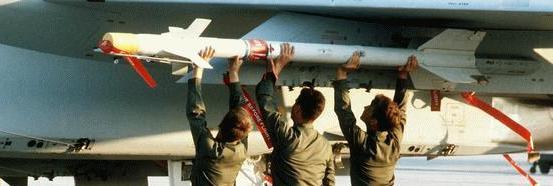 |
| Photo: via FAS |
| AIM-9J/N/P (exact model unknown) |
The designation ZAIM-9K was allocated by the U.S. Navy to a planned upgraded AIM-9H, but development was cancelled in favor of the joint USAF/USN AIM-9L.
In 1971, the USAF and U.S. Navy agreed to jointly develop the AIM-9L, a vastly improved Sidewinder based on the AIM-9H. Major development goals were ALASCA (All-Aspect Capability) and effective use against violently manoeuvering and high-speed targets at all ranges. The AIM-9L had new long-span pointed double-delta canards, a modified MK 36 solid-fuel rocket motor (MODs 8 through 11), and a new AN/DSQ-29 solid-state guidance and control section. Additional improvements include a completely new Argon-cooled Indium Antimonide (InSb) seeker, a DSU-15/B AOTD (Active Optical Target Detector) laser proximity fuze, and an improved 9.4 kg (20.8 lb) WDU-17/B annular blast-fragmentation warhead. All AIM-9L features resulted in a vastly improved missile which could acquire targets at all aspects, and had a much improved tracking, manoeuvering, terminal homing, and killing performance. Production started in 1978, and more than 16000 AIM-9Ls have been built by Philco-Ford, Raytheon, BGT (Germany), and Mitsubishi (Japan). The AIM-9L was used very successfully by the Royal Navy in the Falklands War during 1982.
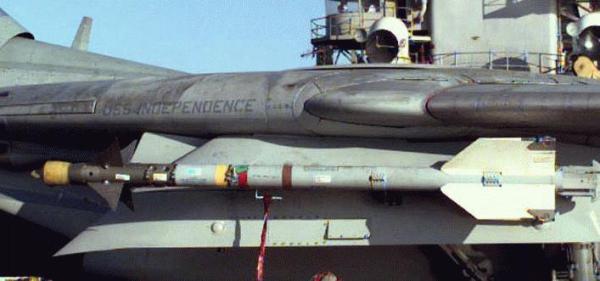 |
| Photo: U.S. Navy |
| AIM-9L/M (exact model unknown) |
Training versions of the AIM-9L are the ATM-9L for firing practice, the captive (non-launching) CATM-9L, and the non-flying DATM-9L for handling and loading practice. There is also a version designated NATM-9L, which is equipped with special test and evaluation equipment. There is also a loading practice version of the AIM-9L known as GDU-6/C. This may be just another (earlier) designation for the DATM-9L.
The AIM-9M is a development of the AIM-9L and replaced the latter on the production line. It features a reduced-smoke rocket motor, an improved guidance section designated WGU-4/B, better countermeasures resistance (IRCCM - Infrared Counter-Countermeasures), and improved overall reliability. Production began in 1982, and so far more than 7000 missiles have been built by Raytheon in subtypes numbered AIM-9M-1 through AIM-9M-10. The principal current production versions are the AIM-9M-8 (USN) and AIM-9M-9 (USAF). They have further improved IRCM detection circuitry, and the latest versions of the rocket motor (MK 36 MOD 11), guidance section (WGU-4E/B), and AOTD (DSU-15B/B). The AIM-9M-10 is a slightly modified -9M-8 for use by the F/A-18E/F Hornet. Most existing AIM-9Ms will be upgraded to -9M-8/9 standard. In Operation Desert Storm in 1991, 13 air-to-air kills were attributed to the Sidewinder, all of which were probably AIM-9M missiles.
 |
| Photo: via NAMSA |
| AIM-9M |
There seem to be no special ATM-9M launch training and DATM-9M ground handling training versions for the AIM-9M. Probably the equivalent -9L versions are used for these purposes. However, there is the CATM-9M captive-carry version, which exists in many subvariants. Variants known to me are the CATM-9M-1/2/4/6/8 (for AIM-9M-1/3 training), CATM-9M-12/14 (for AIM-9M-8/9 training), and CATM-9M-27 (for AIM-9M-10 training). The NATM-9M is a version equipped with special test and evaluation equipment (variants include NATM-9M-1 through -4).
The AIM-9N (originally designated AIM-9J-1) is an improved AIM-9J with all three major circuit boards redesigned for improved seeker performance. Around 7000 were built by Philco-Ford, mainly for export.
The AIM-9P is a USAF-sponsored development of AIM-9J/N, mainly intended for export to countries which can't afford, don't need, or are not allowed to receive the AIM-9L/M. The AIM-9P-1 introduced the DSU-15/B AOTD laser proximity fuze, and the AIM-9P-2 adds a reduced-smoke rocket motor. The AIM-9P-3 has the reduced-smoke motor, a new insensitive munitions warhead, and an improved guidance and control section. Some sources say the -9P-3 retains the original IR fuze of the AIM-9J, while others say that it also uses the new DSU-15/B like the -9P-1. The designation AIM-9P-4 applies to variants with an ALASCA seeker using some of the technology of the AIM-9L/M, and the AIM-9P-5 adds improved IRCCM. Externally, the AIM-9P remains almost identical to the AIM-9J/N. More than 21000 AIM-9Ps have been built so far, many being rebuilt AIM-9B/E/J missiles. Although originally intended for export only, many AIM-9Ps are in the USAF inventory.
The designation AIM-9Q was applied by the U.S. Navy to an AIM-9M development with an upgraded guidance and control section. I have no further information about this version, and it was probably either cancelled or redesignated as an AIM-9M subvariant.
In 1986, development of the AIM-9R began. It was derived from the AIM-9M and equipped with a completely new WGU-19/B IIR (Imaging Infrared) seeker, offering much improved detection and tracking performance in daylight. The first live firing occurred in 1990, but in 1992, the planned production was cancelled due to lack of funding.
The AIM-9S is a stripped-down version of the AIM-9M without the IRCCM system. It is intended for export, and the first customer will be Turkey.
Since the 1980s, the DOD has been searching for a new missile to replace the AIM-9 as its standard short-range "dogfight" air-to-air missile. Original plans to procure the European AIM-132 ASRAAM (Advanced Short-Range Air-to-Air Missile) were dropped, and various test programs were conducted during the late 1980s/early 1990s, including Have Thrust (USAF, classified), Top Hat (USAF/Hughes), Box Office (Loral/Raytheon) and Boa (NWC China Lake). From 1991 on, efforts to develop a Sidewinder follow-on were generally known as "AIM-9X". Following cancellation of the AIM-9R, development of a future dogfight missile based on the AIM-9M began in earnest. In 1994, a Dem/Val (Demonstration/Validation) program for the AIM-9X started, with Hughes and Raytheon as competitors, and in December 1996, Hughes was announced as winner. However, because Raytheon has since acquired the Hughes missile division, Raytheon is now prime contractor for the AIM-9X. The new missile is also officially designated as AIM-9X, so that suffixes -9T/U/V/W are all skipped. Test firings of the AIM-9X began in 1998, and in June 1999, the first guided live firing succeeded to hit a QF-4 target drone. Low-rate initial production was authorized in September 2000, and the first production AIM-9X reached the USAF and USN evaluation units in summer 2002. Initial operational capability with the U.S. Air Force was officially achieved in November 2003, and in May 2004 full-rate production of the missile was approved. By mid-2008, about 3000 AIM-9X missiles had been delivered.
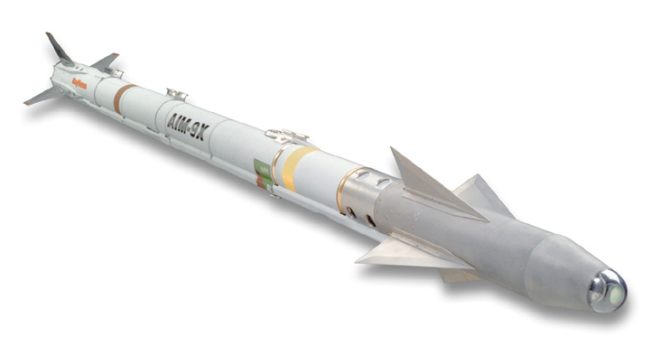 |
| Image: Raytheon |
| AIM-9X |
The AIM-9X retains the MK 36 motor and the WDU-17/B warhead of the AIM-9M. The airframe is new, however, and has much smaller fins and canards for lower drag and higher flight performance. The guidance section is completely new, and features an IIR (Imaging Infrared) seeker. The new WPU-17/B propulsion section has a jet-vane steering system for significantly enhanced agility. The missile is compact enough to fit into the internal weapons bays of stealthy fighters like the F/A-22 Raptor and the F-35 Joint Strike Fighter, but can also be used on existing AIM-9 launchers (like the LAU-7/A series, and the LAU-127/A, -128/A and -129/A series of Common Rail Launchers). The AIM-9X is also fully compatible with the new JHMCS (Joint Helmet-Mounted Cueing System) for target acquisition. Non-tactical versions of the AIM-9X include the captive (non-launching) CATM-9X, the non-flying DATM-9X for handling and loading practice, and the NATM-9X, which is equipped with special test and evaluation telemetry equipment.
Until 2001, more than 150000 AIM-9 Sidewinder missiles of all variants have been built in the USA by Raytheon (current prime contractor), Ford Aerospace (Philco), General Electric, and Motorola. Foreign built missiles raise this number to more than 200000, and production will almost certainly continue for many years. About 270 air-to-air kills worldwide are attributed to the AIM-9.
The graph below summarizes the development line of the AIM-9 missile family. The view of the various AIM-9 variants seems to contain a few minor inaccuracies, but does nevertheless show the major external differences.
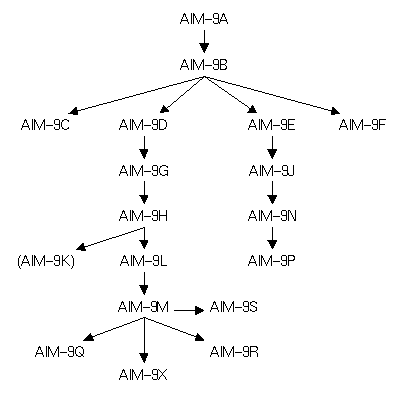 |
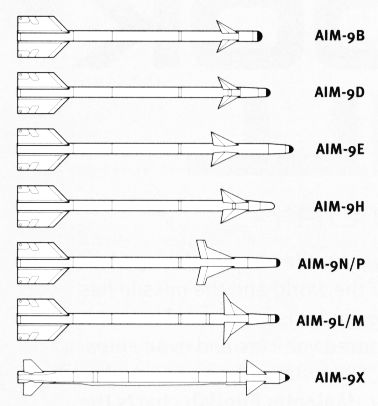 |
| Drawing: Pete West/Key Publishing | |
| AIM-9 development | AIM-9 variants |
Derivatives of the AIM-9 missile are the MIM-72 Chaparral, the AGM-87 Focus, and the AGM-122 Sidearm.
Specifications
Note: Data given by several sources show slight variations. Figures given below may therefore be inaccurate!
Data for AIM-9B/D/E/G/H/J/L/M/N/X:
| AIM-9B | AIM-9D/G/H | AIM-9E | AIM-9J/N | AIM-9L/M | AIM-9X | |
|---|---|---|---|---|---|---|
| Length | 2.83 m (111.5 in) | 2.87 m (113 in) | 3.00 m (118 in) | 3.05 m (120 in) | 2.85 m (112.2 in) | 3.02 m (118.8 in) |
| Finspan | 0.56 m (22 in) | 0.63 m (24.8 in) | 0.56 m (22 in) | 0.58 m (22.8 in) | 0.63 m (24.8 in) | 0.28 m (11 in) |
| Diameter | 12.7 cm (5 in) | |||||
| Weight | 70 kg (155 lb) | AIM-9D: 88 kg (195 lb) AIM-9G: 87 kg (192 lb) AIM-9H: 84 kg (186 lb) |
74 kg (164 lb) | 77 kg (170 lb) | 86 kg (191 lb) | 85 kg (188 lb) |
| Speed | Mach 1.7 | Mach 2.5+ | ? | |||
| Range | 4.8 km (2.6 nm) | 18 km (9.7 nm) | 4.2 km (2.3 nm) | 18 km (9.7 nm) | 40+ km (22+ nm) ? | |
| Propulsion | Thiokol MK 17 solid-fuel rocket | Hercules MK 36 solid-fuel rocket |
Thiokol/Aerojet MK 17 | Hercules/Bermite MK 36 | ||
| Warhead | 4.5 kg (10 lb) blast-fragmentation | 11 kg (25 lb) MK 48 continuous rod | 4.5 kg (10 lb) blast-fragmentation | 9.4 kg (20.8 lb) WDU-17/B annular blast-fragmentation | ||
Main Sources
[1] Norman Friedman: "US Naval Weapons", Conway Maritime Press, 1983
[2] Norman Friedman: "World Naval Weapons Systems, 1997/98", Naval Institute Press, 1997
[3] Bill Gunston: "The Illustrated Encyclopedia of Rockets and Missiles", Salamander Books Ltd, 1979
[4] Christopher Chant: "World Encyclopaedia of Modern Air Weapons", Patrick Stephens Ltd., 1988
[5] Hajime Ozu: "Missile 2000 - Reference Guide to World Missile Systems", Shinkigensha, 2000
[6] Malcolm English: "First Look, First Kill", article in "Air International", August 2001
[7] Carlo Kopp: The Sidewinder Story, 1998
(original article published in "Australian Aviation", April 1994)
Back to Current Designations Of U.S. Unmanned Military Aerospace Vehicles
Back to Directory of U.S. Military Rockets and Missiles
Last Updated: 9 July 2008